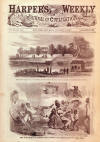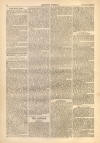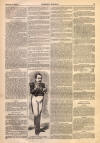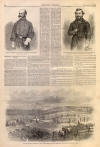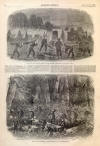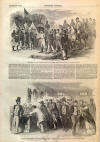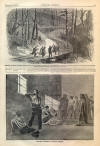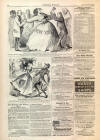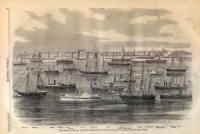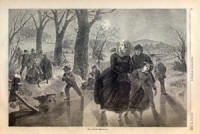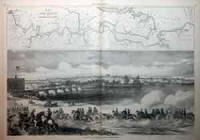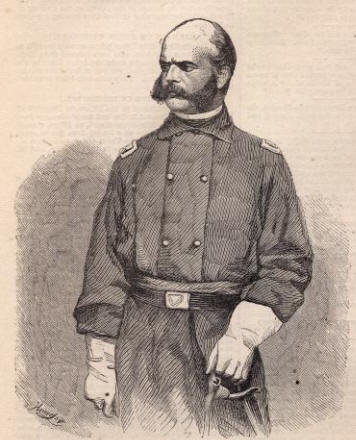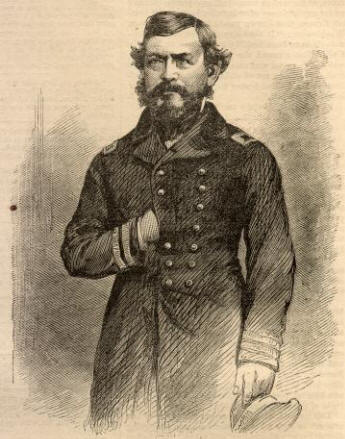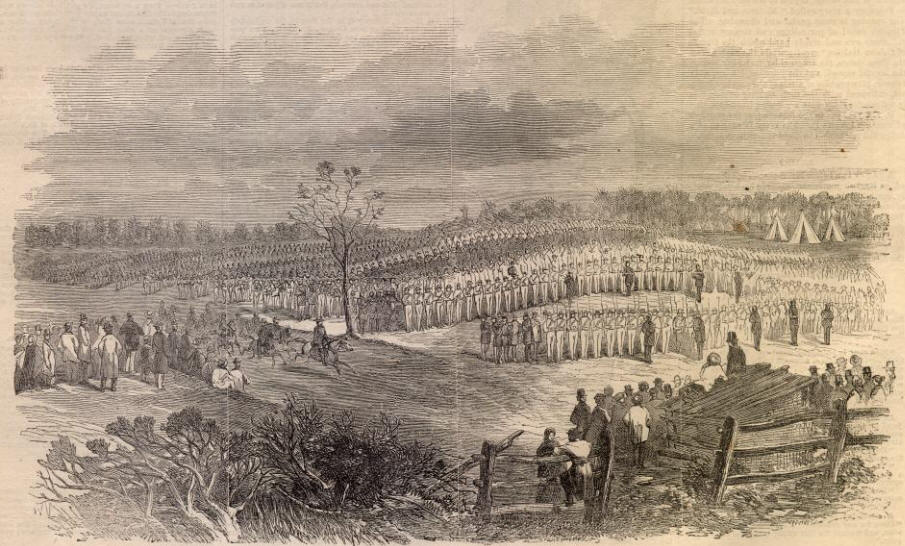|
This Site:
Civil War
Civil War Overview
Civil War 1861
Civil War 1862
Civil War 1863
Civil War 1864
Civil War 1865
Civil War Battles
Confederate Generals
Union Generals
Confederate History
Robert E. Lee
Civil War Medicine
Lincoln Assassination
Slavery
Site Search
Civil War Links
Civil War Art
Mexican War
Republic of Texas
Indians
Winslow Homer
Thomas Nast
Mathew Brady
Western Art
Civil War Gifts
Robert E. Lee Portrait
|
COMMODORE GOLDSBOROUGH, COMMANDING THE NAVAL PART
OF
BURNSIDE'S EXPEDITION.—[PHOTOGRAPHED BY ANTHONY.]
GENERAL BURNSIDE' S EXPEDITION.
WE devote this and the
succeeding
page to illustrations of General Burnside's expedition, to wit: a PORTRAIT OF
THE GALLANT GENERAL himself; a portrait of his naval colleague, COMMODORE GOLDSBOROUGH; a view of the REVIEW OF THE EXPEDITIONARY FORCE which took place
in the last week of December ; and a general view of the TRANSPORT AND GUN-BOAT
FLEET, with Annapolis in the back-ground.
The review was thus described in
the Herald:
Fifteen regiments—fourteen
infantry and one cavalry, numbering fifteen thousand men—were reviewed by
Brigadier-General Foster, commanding the department.
The fine regiment of cavalry (Ira
Harris Guard) was the first to leave its encampment for the scene of operations.
Arriving at the ground first, they took up a position on the left, with the
Fifty-first Pennsylvania and Twenty-fourth Massachusetts, the whole being formed
into three brigades. The different brigades were under the command,
respectively, of Brigadier-General Foster and acting Brigadier-Generals Colonel
Morse and Colonel Heywood. The parade-ground is situated about two miles from
the city, on the railroad line, and afforded a fine opportunity for a good
display of division, brigade, and regimental evolutions, as it embraced some two
thousand acres of smooth ground, with graceful, swelling undulations, which
served to add considerably to the picturesque character of the review. There
were some fifteen thousand men on the ground, and the scene was one of the most
interesting which has ever occupied the attention of the people of the vicinity
of Annapolis, who flocked by thousands in vehicles, on horseback, and on foot to
the parade-ground, every available point around which was taken possession of by
them.
At about eleven o'clock the
reviewing party, consisting of Brigadier-General Foster, Brigadier-General
Hatch, Inspector-General Havelock, Assistant Adjutant-General Richmond, and
Aid-de-Camp Lieutenant D. C. Pell, of General Burnside's staff; Assistant
Adjutant-General Hoffman, and the Aids on General Foster's staff ; Captain E. R.
Goodrich, of the Commissary Department; and various members of the division and
brigade staffs of the post. Following on foot came the Governor of the State and
the members of the Legislature, which is now in session at this place.
Commencing at the right of the column, they minutely inspected the different
regiments, and, of course, expressed themselves highly gratified with the
admirable good order and discipline of the troops. The brigade commanders,
accompanied by their staffs, next reviewed
their respective commands, and the reviewing
party then took up their position at the southern extremity of the ground, at
the right of the troops. Every thing being in . readiness, the clear tones of
command rang along the whole line, and steadily, solidly, regiment after
regiment broke into battalion column. At the word forward the whole body got in
motion and filed by the reviewing generals. The scene presented by the moving
columns far exceeded in grandeur the appearance presented by the troops when
drawn up for inspection, notwithstanding that the latter possessed no ordinary
splendor. The slow march was at times varied with the gay and dashing movement
in " double quick," which exhibited still further the admirable precision with
which the drill of the men had been perfected.
A correspondent of the Evening
Post thus sketches the fleet :
The large steamboats New York and
New Brunswick are chartered to carry troops. There are now in the harbor 14
steamers, 1 propeller, 4 ships, 3 barks, 1 brig, 11 schooners, 5 floating
batteries, besides 2 little dispatch steam-tugs—in all 41 vessels. These are,
perhaps, not half the vessels to be employed in the expedition, which will be
largely reinforced at Fortress Monroe; for, unless the floating batteries are
counted, none of the naval vessels have come to Annapolis. All of the
transports, large and small, are, however, armed, and carry large supplies of
shell and ball for use in the field as well as on board ship.
The transports have been
thoroughly overhauled and completely fitted out with every thing necessary for
the expedition. The steamers are of light draught, and are capable of carrying
from four hundred to six hundred men each, besides stores and ordnance, and when
loaded will draw but from six to eight feet of water. There is no particular
difference in these vessels, and every captain thinks his own, of course, the
best. Every inch of space is devoted to use. Bunks have been erected and
"standees" put up, which can be taken down at short notice, if necessary to
clear the ship for action, or (an unpleasant thought) to afford room for a
cock-pit. The two steamboats New York and New Brunswick will each easily carry a
whole regiment. The propeller Pioneer (formerly the Sherman) carries six guns,
two of them formidable Parrotts, which
speak with (not for) "crackers"
in the shape of 32-pound balls, one 15-pound swivel gun on the forecastle, and
three more 12-pounders. She carries comfortably five hundred troops. Most of the
steamers are equally well armed. The Highlander (once the Cleremont, a
confiscated vessel belonging to William Allen, on the James River) is a schooner
of 500 tons, armed with two 12-pound Parrott guns, and capable of carrying,
besides her crew of twenty-five men, four hundred troop, and eighteen officers.
The ships can carry a much larger
number of men, but will be loaded mainly with provisions and ammunition, and all
the sailing vessels will be towed by the steamers to Fortress Monroe.
The Pickett, a handsome little
propeller of four hundred tons, is the flag-ship of the transport fleet, and is
appropriated by General Burnside and his staff. She
Then close your lines, and strike
home deep amid the traitor clan-
No nobler cause the world has
seen since man first warred with man! L.
into five compartment,, so as to
be beyond the danger of sinking by any ordinary casualty. The Rocket and Grenade
each carry three 32-pound rifled cannon on deck, and the Shrapnel, Grapeshot,
and Bombshell each carry two guns of the same calibre. They will go into action,
and will be valuable additions to the naval part of the expedition.
This general description of a
vessel of each class of those connected with tics expedition is sufficient to
give an idea of the completeness of their outfit. It seems as if nothing was
wanting to render the fleet as formidable as is necessary, and, with the
addition of the naval vessel, now lying at Fortress Monroe, it is believed that
the expedition, in size and strength, will far surpass the one sent to Port
Royal.
THE ARMIES OF THE UNION.
FROM Maine's deep-wooded hills to
far Pacific's Golden Gate,
They gather to the battle with
the slow, sure step of fate. They ask not who their leaders be, they only know
the cause;
Old feuds are hushed as each one
round the sacred banner draws.
They come not here to plunder
foes, they are not urged by hate,
Nor lured by hopes of conquest,
nor by glory's glittering bait;
No conscripts they, constrained
to fight at any master's nod,
But each man is a freeman, who
bows down alone to God.
carries two 12-pound Wiard guns,
and draws but six feet of water. It is not unlikely that when the expedition
reaches the point of attack General Burnside will leave the Pickett, and use the
Cossack as a flag-ship. The Cossack is a fine steamer, formerly the Eastern
City, plying between Boston and St. Johns, New Brunswick, and the newspaper men
are already comfortably quartered on board of her. If she is struck by a shell
the reporters will receive the earliest possible intelligence of the event.
The five floating batteries are
large canal boats, as strong as timbers can make them, and divided
Each claims the nation as his
own, from distant shore to shore;
To each belongs the starry flag
his patriot fathers bore; And each has sworn no rebel knave shall rend the land
in twain,
Or strike one star from off that
flag, so long without a stain.
Full many a soldier's grave
there'll be, full many a darkened home,
Where wives and mothers sickening
wait for those who ne'er shall come.
Yet for each one who nobly falls
another stands prepared To take his place, to wield his arms, and dare all he
has dared.
If fate should frown, and
treason's flag, o'er many a stricken field,
Should proudly wave, theirs is a
blood that knows not how to yield;
But gathering strength with each
reverse, those stubborn ranks would grow,
As the torrent swells amid the
rocks that vainly check its flows.
O could they fail, man's hopes
would fail of freedom evermore!
The peaceful reign of unarmed law
and equal rights were o'er.
GRAND REVIEW OF GENERAL BURNSIDE'S EXPIDITIONARY
FORCE AT
ANNAPOLIS, DECEMBER, 1861.
|
